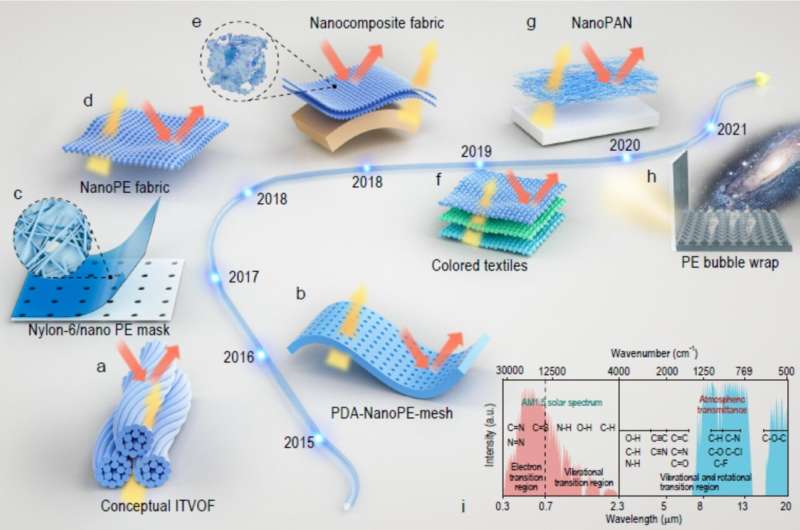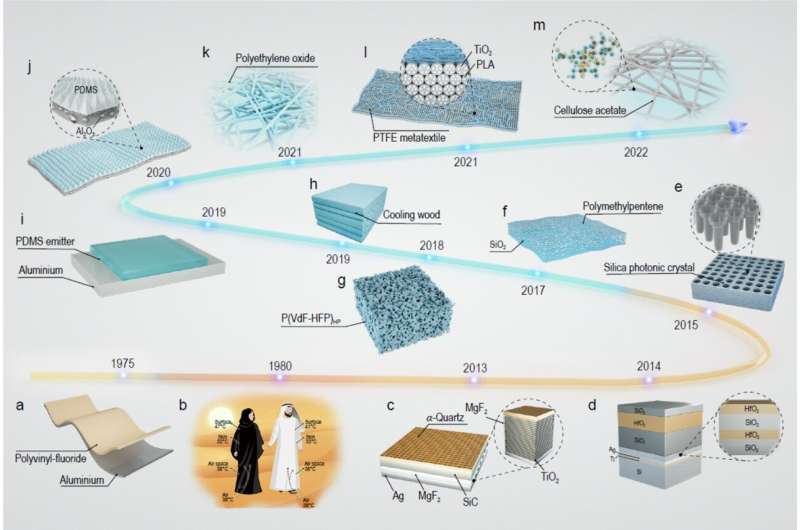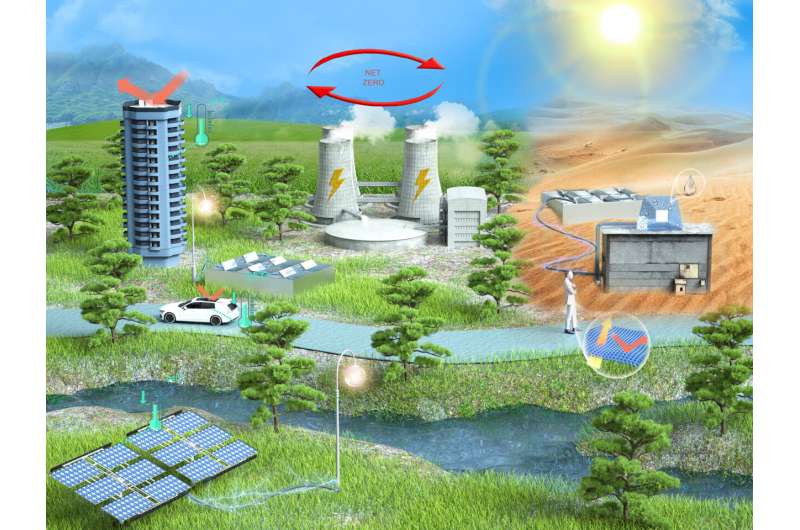(a) Theoretical framework to design IR-transparent fabric. (b) Schematic of polydopamine and nano-porous polyethylene (PDA-NanoPE-mesh) with performance comparable with that of cotton. (c) Diagram of face masks with electrospun nylon-6 nanofibers on needle-punched nanoPE substrate. (d) Schematic of nanoPE fabric with high mid-IR transparency, visible opacity and good wearability. (e) ZnO NPs embedded nano-porous PE fabric. (f) Schematic for the coloration of radiative cooling textiles, which is made by mixing IR-transparent inorganic pigment nanoparticles with PE. (g) Direct radiative cooling using IR-selective transparent covers. (h) Schematic of highly IR-transparent PE bubble warp to block ambient convective heat transfer and ensure the radiative heat transport from objects to outer space. (i) The selection of functional groups for high emittance and low solar absorption. Credit: Science China Press
Increasing global warming and extreme weather are common challenges for humankind, directly affecting individual health and even posing serious threats to lives. Thermal comfort, heating ventilation and air conditioning systems requiring energy supply are widely used in space cooling, resulting in excessive consumption of fossil fuels and significant greenhouse gas emissions.
Massive greenhouse gas emissions have induced the rise of global temperature and climatic anomalies, significantly threatening the existence of life on the Earth. Hence, a new cooling strategy is urgently needed to save energy and reduce emission to protect our living environment and achieve carbon neutrality visions. However, some renewable energy sources are limited by complex systems, geographical, environmental and stability issues.
Therefore, in response to global warming and global carbon neutrality, there is an immediate need for new cooling technologies in sustainable carbon-neutral models to confront the issue of superheating as an effective strategy against the energy challenge.
To cope with these challenges, the research team led by Prof. Guangming Tao (Wuhan National Laboratory for Optoelectronics and Optics Valley Laboratory, Huazhong University of Science and Technology) and Prof. Cheng-Wei Qiu (Department of Electrical and Computer Engineering, National University of Singapore) has proposed a potential radiative cooling paradigm based on structural and material design, and new opportunities for sustainable carbon neutrality as a zero-energy, ecologically friendly cooling strategy have also been presented.
(a) Diagram of coating a metal surface with cheap plastic materials. (b) Enhanced convection of air beneath the black robes carries this heat away before it reaches the skin making it just as effective as the white robes. (c) Diagram of ultra-broadband metal-dielectric photonic structures. (d) Diagram of HfO2-SiO2 photonic film. (e) Diagram of visibly transparent silica photonic crystal. (f) Diagram of the scalable-manufactured glass-polymer hybrid metamaterial. (g) Diagram of hierarchically porous polymer coatings. (h) Diagram of the cooling wood structure. (i) A schematic diagram of the planar PDMS/metal thermal emitter. (j) Artificially fabricated radiative coolers based on the fluff structure of N. gigas. (k) Effective scattering diagram of micro- and nano-structures of the es-PEO film. (l) Hierarchical-morphology metafabric for scalable radiative cooling. (m) Diagram of the intrinsic molecular vibrations and porous structure of the cellulose acetate (CA) film. Credit: Science China Press
This technology uses broad-spectrum selective and precise regulation to meet the cooling needs of multiple scenes through targeted optimization of optical structures, ultimately achieving sustainable passive radiative cooling. Shortly after being published, this article had already been cited in Wikipedia under the terms "Carbon neutrality" and "Passive daytime radiative cooling".
In order to achieve effective cooling, traditional indoor cooling methods consume large amounts of energy. Therefore, based on mid-infrared high-transmission radiation cooling, Chen, Cui and Lenert et al. designed wearable cooling devices to achieve passive and efficient indoor cooling by reflecting visible light as well as emitting heat radiation through the human body to the surrounding environment. However, passive cooling for hot outdoor environments is still a pressing issue.
In outdoor environments, strong solar radiation is another important factor that causes the temperature of object to rise in addition to thermal radiation. Therefore, Fan and Zhu et al. achieved passive cooling function by designing radiative cooling devices to precisely modulate solar radiation and mid-infrared radiation, but it is difficult to achieve low cost and mass fabrication.
Radiative cooling is applied in a series of everyday life and extreme scenarios. Credit: Science China Press
Yang, Zhu, and Tao et al. introduced randomly distributed micro and nanoscale scatterers for sustainable and efficient outdoor passive cooling when fabricated on a large scale. Scientists have developed thin film, coating, cooling wood, metafabric and other devices to achieve energy savings of 7–45% using stable and sustainable passive cooling recipes.
It has been established that peak CO2 emissions and subsequent carbon neutrality are predominant global challenges for future societal development. This review further discussed the future application scenarios of radiative cooling in the context of sustainable carbon neutrality strategies for passive and efficient space cooling needs and presents the development trends, technical challenges, and potential solutions for radiative cooling in the context of current research.
The research was published in National Science Review.
More information: Jun Liang et al, Radiative cooling for passive thermal management towards sustainable carbon neutrality, National Science Review (2022). DOI: 10.1093/nsr/nwac208
Provided by Science China Press


























